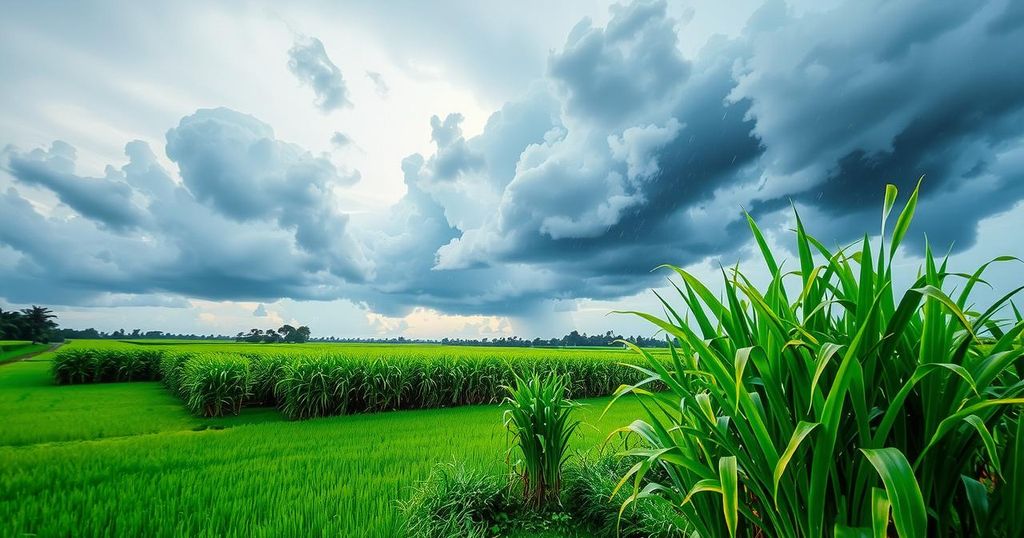Sugar prices have dropped due to forecasted rain in Brazil, easing dryness concerns, and a weaker Brazilian real encouraging export sales. The International Sugar Organization has raised its global sugar deficit outlook, while projections indicate lower production in India and Brazil. Conversely, increased sugar output is expected from Thailand, suggesting a complex market environment.
Sugar prices have experienced a decline this week, with May NY world sugar 11 down by 0.79%, and May London ICE white sugar 5 reducing by 0.35%. The decrease is attributed to forecasted rainfall in Brazil, which alleviates concerns over dryness in sugar-growing regions. These weather reports suggest widespread showers likely to continue into the following week, impacting prices negatively.
In conjunction with rainfall forecasts, the Brazilian real has depreciated, reaching a two-week low. A weaker real provides Brazilian sugar producers with an incentive to increase export sales, further applying downward pressure on sugar prices. Comparatively, last Tuesday saw sugar prices reach a one-month high in New York and a four-month high in London due to indications of reduced global production.
Recent reports indicate that India’s sugar production forecast for 2024/25 has been revised downward, now projected at 26.4 million metric tons (MMT), attributing the decrease to lower cane yields. Concurrently, Brazil’s Center-South sugar output for the current season has fallen 5.3% compared to the previous year, totaling 39.983 MMT. Additionally, sugar trader Czarnikow has decreased its Brazil 2025/26 sugar production estimate from 43.6 MMT to 42 MMT.
The International Sugar Organization has also heightened its deficit forecast for global sugar, now estimated at 4.88 MMT for 2024/25, contrasting with a surplus of 1.31 MMT in the previous season. This adjustment coincides with a lowered projection for worldwide production, now at 175.5 MMT.
Despite bearish trends, Datagro has forecast an increase in Brazil’s sugar production for 2025/26, potentially rising to 42.4 MMT, a 6% increase year-on-year. Moreover, a projection from Green Pool suggests that the sugar market may shift to a surplus in the 2025/26 crop year, moving from a projected deficit for 2024/25.
On another note, the Indian government has announced that sugar mills would be permitted to export 1 MMT of sugar this season, thereby relaxing previously imposed export restrictions. The Indian Sugar Mills Association anticipates that the country’s production will decline significantly, estimated at 26.4 MMT for 2024/25, marking a five-year low.
Outlook for sugar production in Thailand appears positive, with an anticipated increase of 18% for the 2024/25 season, estimating production at 10.35 MMT. Thailand, being the third-largest sugar producer globally, could impact global sugar prices.
Additionally, factors such as drought and heat in Brazil have led to substantial crop losses due to fires, particularly affecting São Paulo, Brazil’s top sugar-producing state. Following these events, the government crop forecasting agency, Conab, has reduced Brazil’s sugar production estimate for 2024/25 to 44 MMT, reflecting the adverse weather conditions.
The USDA’s bi-annual report indicates an expectation of 2024/25 global production growth of 1.5% to a record high of 186.619 MMT, corresponding with a 1.2% increase in global sugar consumption to 179.63 MMT. This report further anticipates a decline in ending stocks by 6.1%.
The recent decline in sugar prices is influenced by factors such as improved weather forecasts in Brazil, a weakened Brazilian real, and adjusted global production estimates. While bearish factors, including anticipated increases in production from Brazil and Thailand, also play a role, the overall market exhibits a precarious balance between potential deficits and surpluses, necessitating careful observation in forthcoming seasons.
Original Source: www.tradingview.com






